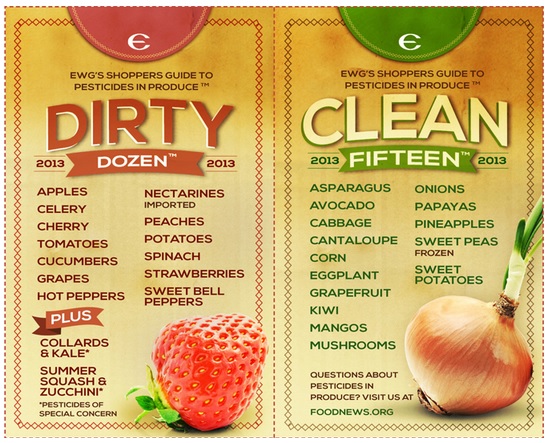Every year the Envirnmental Working Group publishes a list they call the Dirty Dozen. These are the top (or bottom, depending on how you look at it) 12 fruits and vegetables based on the amount of pesticides found on them. These are the fruits nd vegetables you should be sure to buy organic. Along with that is the list of 15 fruits and vegetables with the least pesticides which are okay to buy conventionally grown.
Here are the lists:
Apples
Strawberries
Grapes
Celery
Peaches
Spinach
Sweet bell peppers
Nectarines – imported
Cucumbers
Cherry tomatoes
Snap peas – imported
Potatoes
Sweet potatoes
Cauliflower
Cantaloupe
Grapefruit
Eggplant
Kiwi
Papaya
Mangoes
Asparagus
Onions
Sweet peas – frozen
Cabbage
Pineapples
Sweet corn
Avocados
Here is last year's list:

 Martha Rosenberg, AlterNet
Martha Rosenberg, AlterNet
Waking Times
It is no secret that in the war against meat pathogens in commercial U.S. meat production, the pathogens are winning. The logical result of the tons of antibiotics Big Meat gives livestock (not because they are sick, but to fatten them up) is clear: antibiotics that no longer work against antibiotic-resistant diseases like staph (MRSA), enterococci (VRE) and C.difficile. Antibiotic-resistant infections, once limited to hospitals and nursing homes, can now be acquired in the community, Florida public beaches and on the highway behind a poultry truck.
Big Meat has found some novel ways to retard the growth of salmonella, E.coli and listeria on commercially grown meat, but it does not necessarily want people to know about them and these substances are conspicuously absent from labels.
1. Chlorine Baths
If you want to know the most problematic ingredients in our food supply, just look at the items the European Union boycotts, starting with GMOs, hormone beef and chicken dipped in chlorine baths. U.S. Big Food lobbyists are pushing hard to circumvent the European bans, says MintPress News, especially “bleached chicken.” They claim the “many unwarranted non-tariff trade barriers… severely limit or prohibit the export of certain U.S. agricultural products to the EU.”
2. Ammonia
In November, Ag giant Cargill announced it is bringing back pink slime, with two changes—instead of ammonia, E.coli will be killed with citric acid and the meat will be identified as “Finely Textured Beef” on its label.
3. Carbon Monoxide
Why is Cargill’s name actually written into government directives? Maybe because it’s one of the world’s biggest Ag players according to Rain Forest Action. With annual revenues bigger than the GDP of 70 percent of the world’s countries, Cargill is the world’s largest privately held corporation, says Rain Forest Action. It operates in more than 66 countries and is one of a “very small handful of agribusiness giants that collectively are shaping the increasingly globalized food system to their advantage.”
4. Other “Safe and Suitable” Ingredients You Don’t Know You’re Eating
Unless you’re a chemist, you may not recognize some of the other ingredients in the 2014 FSIS directive, but that doesn’t mean you want to ingest them. Take “cetylpyridinium with propylene glycol for bacterial control.” While cetylpyridinium is a germ-killing compound found in mouthwashes, toothpastes and nasal sprays, in meat production it is combined with propylene glycol to “treat the surface of raw poultry carcasses or parts (skin-on or skinless).” Yum.
How about, “aqueous solution of sodium octanoate, potassium octanoate, or octanoic acid and either glycerin and/or propylene glycol and/or a Polysorbate surface active agent,” also to kill germs?
And, does anyone want to eat “hen, cock, mature turkey, mature duck, mature goose, and mature guinea” into whose raw meat and tissue has been injected protease produced from the mold Aspergillus for tenderness?
Another unrecognizable chemical is sodium tripolyphosphate, used as an “anti-coagulant for use in recovered livestock blood which is subsequently used in food products,” says FSIS. According to Food and Water Watch, seafood like scallops, shrimp, hake, sole or imitation crab meat may be soaked in sodium tripolyphosphate to make it appear firmer, smoother and glossier. Sodium tripolyphosphate, “a suspected neurotoxin, as well as a registered pesticide and known air contaminant in the state of California,” says Food and Water Watch, also can make seafood weigh more. To avoid sodium tripolyphosphate, buy fish labeled as “dry,” says Food and Water Watch and avoid seafood marked as “wet.” We have not found advice on how to avoid the chemical in meat.
5. Bacteriophages
An underreported way in which Big Food is seeking to kill meat pathogens, especially antibiotic-resistant pathogens, is with bacteriophages. Phages are viruses that infect and kill bacteria, essentially turning the bacteria cell into a phage production factory until the bacteria cell bursts, releasing hundreds of copies of new phages, which go on to infect and kill more bacteria. Phages, discovered in 1919, were used to treat bacterial infections but fell out of favor when antibiotics became widely available in the 1940s. Antibiotics had the advantage of attacking more than one bacterium at the same time and were not usually recognized by a patient’s immune system, so they could be used over and over in the same person to fight bacterial infection without producing any immune response.
In 2008, OmniLytics, Inc. announced FSIS approval (issuance of a no-objection letter) for a bacteriophage treatment for poultry it developed in conjunction with Elanco, the animal division of Eli Lilly to reduce salmonella. Other, similar products soon surfaced for meat production. At least nine bacteriophage uses are listed in the FSIS 2014 directive, mostly sprayed on the hides or feathers of live animals to reduce bacterial count before slaughter. While phages are certainly “greener” than antibiotics, there are two reasons many food activists do not laud the development. Bacteriophages accommodate rather than reform the high-volume, low-ethics factory farming and do not clean up drug excesses. The other reason is phages could become yet another tool of factory farming. Cattle and other livestock operators could use phages to make animals gain weight without risking antibiotic resistance, observed a recent documentary.
About the Author
Martha Rosenberg is an investigative health reporter and the author of “Born With a Junk Food Deficiency: How Flaks, Quacks and Hacks Pimp The Public Health (Random House).”
~~ Help Waking Times to raise the vibration by sharing this article with the buttons below…
The post 5 Dangerous Substances Big Ag Pumps Into Your Meat appeared first on Waking Times.

Recently Big Pharma's Tamiflu was exposed as ineffective against the flu. But researchers have discovered that natural ginseng extract may succeed where patented synthetic chemicals have failed.

No comments:
Post a Comment